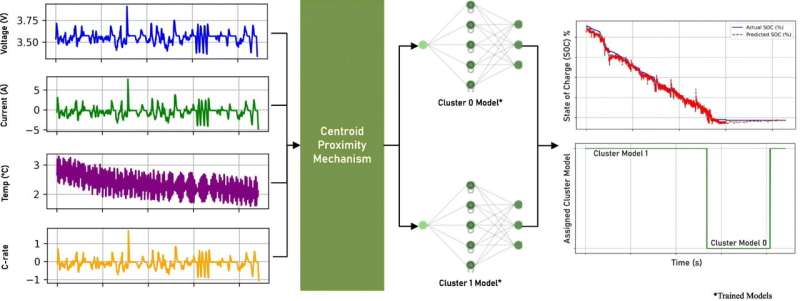August 21, 2024 dialog
This article has been reviewed according to Science X's editorial process and policies. Editors have highlighted the following attributes while ensuring the content's credibility:
fact-checked
trusted source
written by researcher(s)
proofread
Energizing the future: AI innovations for longer-lasting lithium-ion batteries

We are excited to present an advancement in the management of lithium-ion battery performance, a critical component in the transition towards sustainable energy. Our team from the School of Engineering, Technology, and Design at Canterbury Christ Church University, U.K., has focused on utilizing machine/deep learning to enhance the State of Charge (SOC) estimation for lithium-ion batteries, particularly those being repurposed for second-life applications.
The efficient and safe operation of lithium-ion batteries is essential for reducing reliance on fossil fuels, supporting the proliferation of electric vehicles, and enabling renewable energy sources to power infrastructure. A key challenge in this domain is the accurate estimation of SOC. Misestimating SOC can lead to overcharging or deep discharging, both of which can significantly degrade battery performance and lifespan.
The challenge of SOC estimation
SOC functions as the fuel gauge for a battery. Just as it is undesirable to run out of fuel unexpectedly, it is crucial to prevent a battery from depleting or charging beyond safe limits. Accurate SOC estimation is vital for ensuring the longevity and safety of batteries, especially in electric vehicles and large-scale energy storage systems.
Our recent study, published in the Journal of Energy Storage, addresses this challenge through a novel approach. We developed a Cluster-Based Learning Model (CBLM), integrating K-Means clustering with Long Short-Term Memory (LSTM) networks. Clustering allows for the grouping of similar data points, facilitating pattern prediction.
By combining clustering with LSTM, which excels at handling sequences and time-series data, the precision of SOC estimations is significantly improved. A key feature of this model is the centroid proximity selection mechanism, which dynamically selects the most appropriate cluster model in real-time based on the battery's operational data.
Testing and results
The method was tested using data from a Tesla Model 32,170 lithium-ion battery cell. The results were remarkable, achieving a Root Mean Square Error (RMSE) of 0.65% and a Mean Absolute Error (MAE) of 0.51%. This method outperformed existing techniques by reducing errors by more than 60%, demonstrating robustness and reliability for real-world applications.
To understand the practical implications, a further examination of the impact of improved SOC estimation on battery health and economic performance was conducted. The CBLM model was compared against the Standard LSTM model using a second-life EV battery degradation model in an energy arbitrage application.
The enhanced SOC estimation method demonstrated significant improvements in maintaining battery health over extended periods and across various temperature conditions, particularly in high depth charging and discharging scenarios. Economically, this method increased profitability over a seven-year period, especially in scenarios with high depth of discharge, resulting in substantial cost savings.
Accurate SOC estimation ensures the reliability and safety of batteries in electric vehicles, enhances the efficiency of energy storage systems, and facilitates the effective repurposing of second-life batteries, thereby extending their lifecycle and reducing waste. The adaptability of this approach allows its application to various operational environments, making it a versatile tool in the pursuit of sustainable energy solutions.
This advancement marks a significant step towards a sustainable energy future. Collaboration with industry partners is sought to transition this innovation from the lab to practical applications. In conclusion, enhancing SOC estimation contributes to making batteries smarter, more reliable, and safer, advancing towards a world powered by clean energy.
This story is part of Science X Dialog, where researchers can report findings from their published research articles. Visit this page for information about Science X Dialog and how to participate.
More information: Mohammed Khalifa Al-Alawi et al, A novel enhanced SOC estimation method for lithium-ion battery cells using cluster-based LSTM models and centroid proximity selection, Journal of Energy Storage (2024). DOI: 10.1016/j.est.2024.112866. doi.org/10.1016/j.est.2024.112866
Mohammed Al-Alawi is a PhD researcher at Canterbury Christ Church University, specializing in Energy Storage and Renewable Energy Engineering. His research focuses on developing sustainable solutions for repurposing retired electric vehicle batteries, with an emphasis on enhancing State of Charge (SOC) estimation using machine/deep learning techniques. He holds a Master’s degree in Renewable Energy Engineering and a Bachelor’s degree in Electrical and Electronic Engineering.















